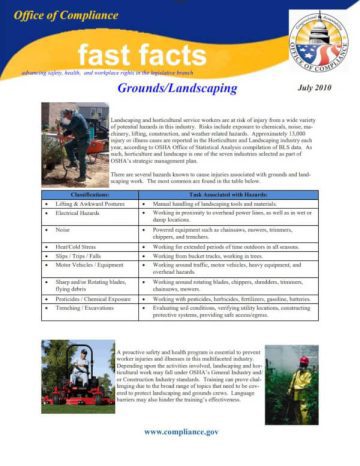Landscaping and horticultural service workers are at risk of injury from a wide variety of potential hazards in this industry. Risks include exposure to chemicals, noise, machinery, lifting, construction, and weather related hazards. Approximately 13,000 injury or illness cases are reported in the Horticulture and Landscaping industry each year, according to OSHA Office of Statistical Analysis compilation of BLS data. As such, horticulture and landscape is one of the seven industries selected as part of OSHA’s strategic management plan.
There are several hazards known to cause injuries associated with grounds and landscaping work. The most common are found in the table below.
| Classifications: | Task Associated with Hazards: |
| Lifting & Awkward Postures | Manual handling of landscaping tools and materials. |
| Electrical Hazards | Working in proximity to overhead power lines, as well as in wet or damp locations. |
| Noise | Powered equipment such as chainsaws, mowers, trimmers, chippers, and trenchers. |
| Heat/Cold Stress | Working for extended periods of time outdoors in all seasons. |
| Slips / Trips / Falls | Working from bucket trucks, working in trees. |
| Motor Vehicles / Equipment | Working around traffic, motor vehicles, heavy equipment, and overhead hazards. |
| Sharp and/or Rotating blades, flying debris | Working around rotating blades, chippers, shredders, trimmers, chainsaws, mowers. |
| Pesticides / Chemical Exposure | Working with pesticides, herbicides, fertilizers, gasoline, batteries. |
| Trenching / Excavations | Evaluating soil conditions, verifying utility locations, constructing protective systems, providing safe access/egress. |
A proactive safety and health program is essential to prevent worker injuries and illnesses in this multifaceted industry.
Depending upon the activities involved, landscaping and horticultural work may fall under OSHA’s General Industry and/or Construction Industry standards. Training can prove challenging due to the broad range of topics that need to be covered to protect landscaping and grounds crews. Language barriers may also hinder the training’s effectiveness.
Lawn and Landscape Maintenance: This activity includes such tasks as mowing, pruning, chipping, fertilizing, leaf blowing, pest control, and providing safe transport for crew to and from the job site.

